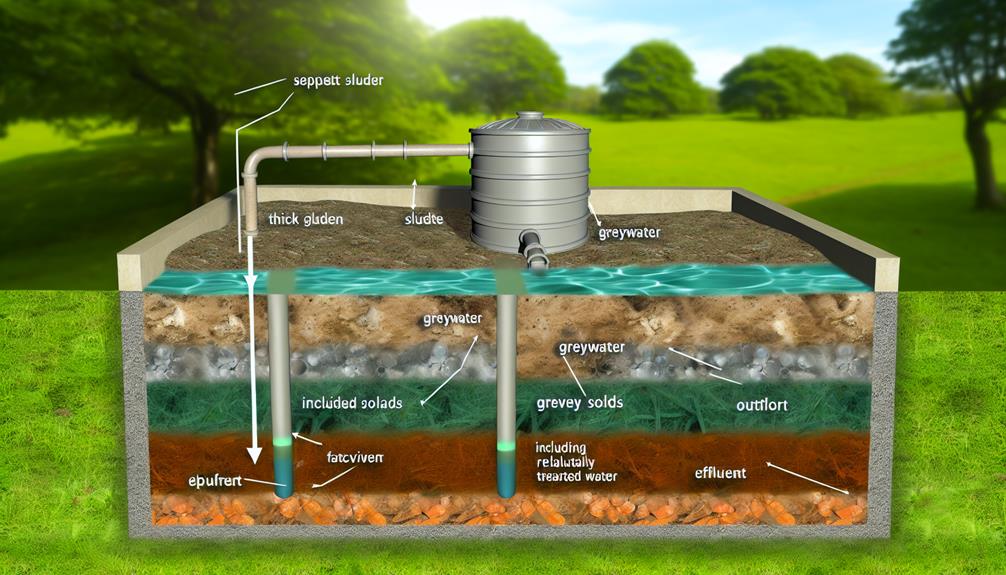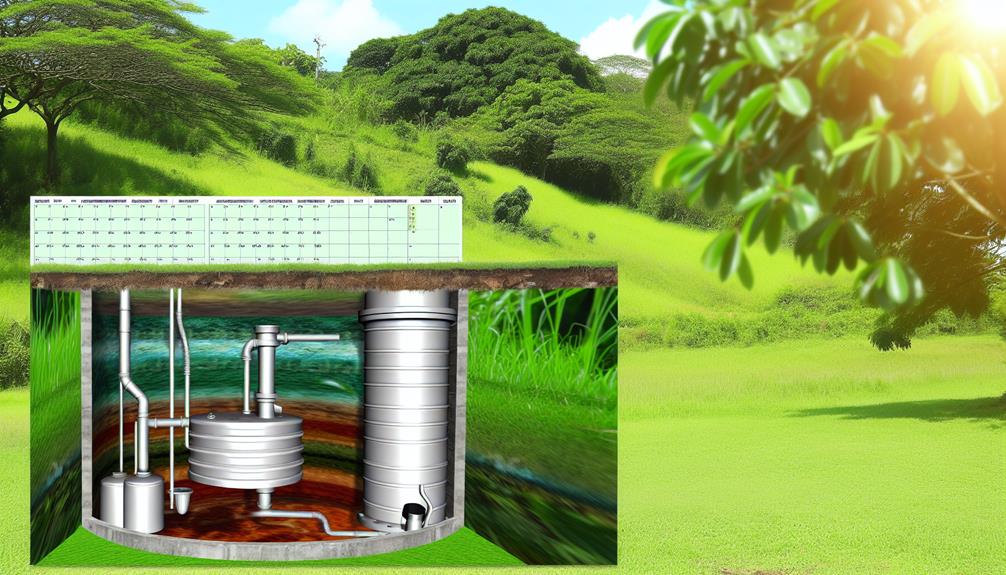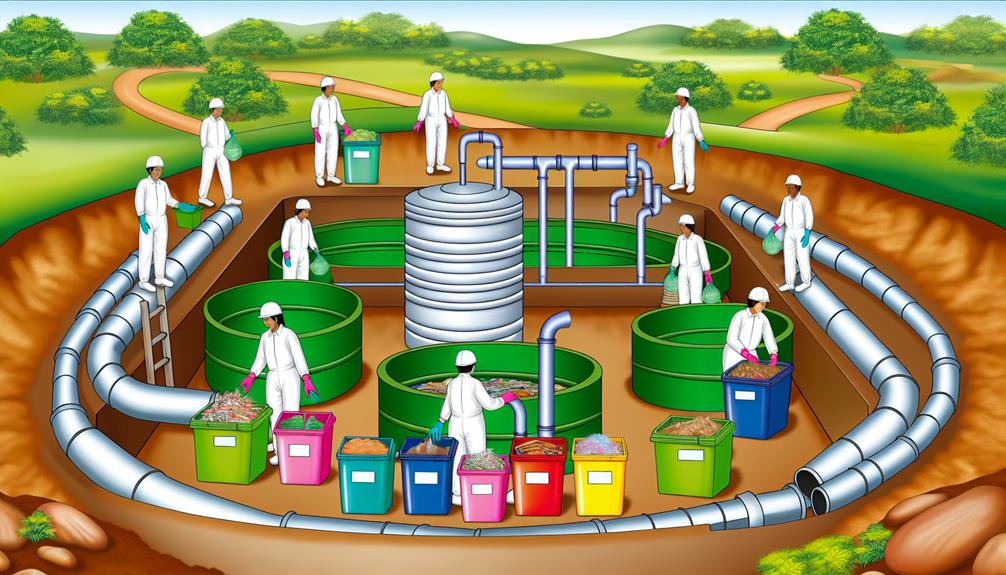Discover how to protect your septic system from breakdown with...
Read MoreYou & Your Septic Tank
6 Best Practices for Health-Safe Septic Tank Maintenance
Our professional septic service team offers comprehensive septic tank pumping services to keep your system running smoothly. Get a FREE Quote Today.

6 Best Practices for Health-Safe Septic Tank Maintenance
‘An ounce of prevention is worth a pound of cure,’ as the old saying goes, and this certainly holds true when it comes to maintaining your septic system. You might not give it much thought, but a poorly maintained septic tank can pose serious health risks, not to mention the potential damage to your property and the environment.
So, how do you keep your septic tank in top shape while ensuring the health and safety of your household? We’re about to discuss six crucial practices that will help you achieve this.
However, one might wonder, what surprising risks could you be taking by ignoring your septic tank?
Key Takeaways
- Regular septic tank inspections are crucial for proper maintenance and should be conducted every 3-5 years, or more frequently for larger households or heavy usage.
- Routine pumping every 3-5 years is essential to prevent the accumulation of solid waste, blockages, and contamination of nearby water sources.
- Protecting the health of the drainfield is important by avoiding overload, monitoring vegetation growth, conducting soil analysis for proper sizing, implementing rainwater management, and promptly fixing leaks.
- Proper waste disposal is vital to maintain septic tank health, including educating on waste segregation, using eco-friendly cleaners, and avoiding the disposal of chemicals, oil, plastic, and sanitary products. Regular pumping and inspections help prevent issues and detect problems early.
Understanding Septic Tank Functionality

To ensure the longevity of your septic system, it’s crucial to understand how your septic tank functions. The tank’s construction and the role of bacteria are two fundamental aspects that you can’t overlook in this process.
Your septic tank’s construction is its backbone. It’s usually made from durable materials like concrete, plastic, or fiberglass. Its primary function is to hold wastewater long enough for solids to settle at the bottom, forming sludge, while oil and grease rise to the top to create scum.
Now, let’s talk about the bacteria’s role. They’re the unsung heroes of your septic system. These microscopic organisms play a pivotal role in breaking down the solid waste materials in the tank. They help transform these solids into a liquid form that’s easier to treat and dispose of.
Understanding these aspects can help you maintain your septic system better. You’ll be more aware of any disruptions that may occur, enabling you to act promptly to rectify any issues.
Regular Septic Tank Inspections
Having understood the fundamental workings of your septic system, it’s equally important to recognize the value of regular septic tank inspections in maintaining its efficiency and longevity.
These inspections allow for early detection of potential issues, saving you from costly repairs down the line. The inspection frequency depends on various factors such as tank size, household usage, and local regulations but a general rule of thumb is to have your septic tank inspected every three to five years.
However, not all inspections are created equal. The inspector qualifications play a pivotal role in ensuring a comprehensive and accurate assessment.
Consider these points when scheduling your next inspection:
- Inspection Frequency
- Schedule inspections every 3-5 years
- Increase frequency for larger households or heavy usage
- Follow local regulations regarding inspection intervals
- Inspector Qualifications
- Ensure the inspector is certified and experienced
- Check for affiliation with professional bodies
- Ask for references and check reviews
- Inspection Process
- Full system inspection, not just the tank
- Detailed report with findings and suggestions
- Follow-up service if needed
Importance of Routine Pumping

Regularly pumping your septic tank is crucial in preserving its functionality and preventing potential system failures. Pumping frequency largely depends on the tank’s size, the number of people in your household, and the volume of wastewater generated. Typically, you should pump your septic tank every three to five years.
Pumping out your septic tank ensures that solid waste doesn’t accumulate and lead to blockages or system backups. It’s also vital in preventing the contamination of nearby water sources, which could pose a severe health risk.
However, don’t wait until you’re facing an emergency to pump your tank. Emergency pumping often results from neglecting routine maintenance, and it can be a costly and inconvenient affair. It’s far more efficient and economical to stick to a regular pumping schedule.
Protecting Drainfield Health
Protecting the health of your drainfield is a crucial part of septic tank maintenance. You should prioritize preventing drainfield overload, as this can cause significant damage to your system.
Additionally, careful monitoring of vegetation growth in and around your drainfield is key to maintaining its efficiency and longevity.
Preventing Drainfield Overload
To ensure the health of your drainfield, it’s crucial to prevent overload, which could lead to costly repairs and serious environmental consequences. A key part of this is conducting a thorough soil analysis and considering effective rainwater management strategies.
Here are some steps you can take:
- Undertake regular soil analysis:
- This helps in identifying the percolation rate of your soil.
- Based on the results, you can determine the drainfield size that best fits your soil type.
- Implement rainwater management:
- Direct downspouts and rainwater drainage systems away from the drainfield area.
- Consider rain gardens or other eco-friendly solutions to manage excess water.
- Monitor your water usage:
- Avoid overloading the system by conserving water.
- Fix leaks promptly and consider high-efficiency fixtures.
Monitoring Drainfield Vegetation
Keeping a close eye on the vegetation over your drainfield is an essential step in maintaining its health and functionality. Certain vegetation types can cause damage, while others ensure soil compatibility.
Consider the following table:
| Vegetation Type | Impact on Drainfield |
|---|---|
| Deep-rooted trees | Can damage the drainfield structure |
| Grass | Helps prevent soil erosion and enhances evaporation |
Awareness of vegetation types and their impacts are crucial. Deep-rooted trees can penetrate and damage your drainfield structure, leading to costly repairs. On the other hand, grass is beneficial as it prevents soil erosion and enhances evaporation. Understanding the relationship between vegetation types and soil compatibility will help you in maintaining a healthy, functional septic system.
Proper Disposal of Waste

When it comes to maintaining your septic tank, it’s crucial to understand the importance of properly disposing of waste. This key process, when done correctly, not only ensures the longevity of your septic system but also protects the environment.
Waste Segregation Education: It’s vital to know what can and can’t go into your septic tank. Here’s a simple guide:
- Can go: Human waste, toilet paper
- Can’t go: Chemicals, oil, plastic, sanitary products
Eco-friendly Cleaners: Using eco-friendly cleaners can help maintain a healthy septic tank. They don’t harm the essential bacteria in the tank that break down waste.
Maintenance Tips: Regular pumping and inspections can help prevent failures. Here’s how to approach it:
- Pumping: Have your tank pumped every 3-5 years by a professional.
- Inspections: Hire a professional to inspect your tank every year to detect issues early.
Risks of Neglecting Septic Maintenance
Neglecting your septic tank maintenance can lead to severe consequences.
You’re not just risking your health, but you’re also potentially harming the environment and setting yourself up for costly repairs.
We’ll explore these three critical risks in more detail in the following sections.
Health Hazards of Neglect
Often, homeowners underestimate the health risks associated with neglecting regular septic tank maintenance. This negligence can result in disease transmission and contaminated groundwater.
- Disease Transmission:
- Direct Contact: Failing to maintain your septic tank can lead to sewage overflow, which may expose you and your family to harmful pathogens.
- Indirect Contact: These pathogens can contaminate surfaces in and around your home, increasing the risk of disease transmission.
- Contaminated Groundwater:
- Drinking Water: Unchecked septic systems can leach harmful bacteria into your groundwater, jeopardizing your drinking water supply.
- Ecosystem Impact: This contamination not only affects human health, but also harms local ecosystems.
Environmental Impact
In addition to the serious health hazards, ignoring regular septic tank maintenance also has dire implications for the environment. Leaking septic systems can contaminate groundwater with harmful bacteria and chemicals, impacting local ecosystems. Moreover, excessive nutrients from wastewater can cause algal blooms in nearby bodies of water, disrupting aquatic life.
To prevent these effects, it’s essential to employ sustainable practices in your septic maintenance routine. Use eco-friendly cleaners that won’t harm the beneficial bacteria in your system, reducing the risk of system failure and environmental contamination. Regular inspections can also help detect potential issues early on, minimizing their impact on the environment.
Increased Repair Costs
While it’s tempting to overlook routine septic maintenance to save time and money, you’ll find that this approach often leads to far greater repair costs down the line. This costly negligence can result in unforeseen expenses that can seriously strain your budget.
Here’s how neglecting septic maintenance can affect your wallet:
- Unanticipated system failure:
- Damage to internal components
- Complete system replacement
- Frequent, smaller repairs:
- Repeated plumber visits
- Ongoing replacement of parts
- Property damage:
- Landscaping repairs
- Structure damage from backups
Conclusion
Properly preserving your septic system’s functionality is fundamental for your family’s health. Regular inspections and routine pumping are paramount to prevent problems. Protect your drainfield diligently and dispose of waste wisely to ward off unwanted issues.
Neglecting septic maintenance multiplies risks, resulting in repair-related ruckus. Remember, maintaining your septic system might seem mundane, but it’s a must for maintaining a healthy home.
You may also like...
Why Are DIY Fixes Essential for Septic Tank Pumping?
Tap into the importance of DIY fixes for septic tank...
Read MoreUnveiling the Average Costs of Septic Tank Pumping
Master the mysteries of septic tank pumping costs and avoid...
Read More
The Best Septic Tank Pumping Services Near You

Answer Some Questions
Let us know about your needs so we can find you the right septic tank pros.

Get Quotes
We will put you in touch with the right septic tank pros for your job and location.

Hire Right
Compare quotes, message or call pros, and hire only when ready.



